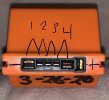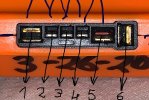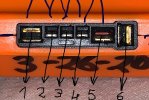Buongiorno, sto cercando di mettere ordine nei miei pensieri riguardo alla ricarica delle mie batterie H+, una è già andata e credo che la seconda sia sulla stessa strada anche se non è gonfia ma non è stata utilizzata per due o tre anni.
La batteria è una YUNTYHP101 5250Ah.
L'ho messo in carica, ma dopo due o tre minuti il LED verde lampeggiante è diventato blu lampeggiante lentamente e il cicalino all'interno del caricabatterie SC4000-4H ha iniziato a suonare in modalità intermittente.
Devo sottolineare che l'intero complesso di carica è stato precedentemente utilizzato per ricaricare la batteria ST16S. Infatti, una volta accesa, indicava che la batteria era carica al 100%. Questo aprirà un altro argomento.
A questo punto ho bisogno di due informazioni:
1) È possibile verificare se la batteria in questione funziona?
2) è possibile ricaricare la batteria con un caricabatteria diverso da quello in dotazione?
3) Se si scoprisse che anche questa batteria deve essere buttata via, dove e quale batteria potrei acquistare, visto che a quanto pare YUNEEC è diventata un'entità sconosciuta.
Per quanto riguarda l'altro argomento, cioè il caricabatteria originale, quanto descritto a riguardo e le istruzioni per la carica dei due tipi di batterie, noto che non c'è convergenza operativa tra quanto descritto e la realtà di ciò che accade durante la carica... o almeno ciò che accade sul mio.
La caricabatteria che possiedo indica che con il LED VERDE lampeggiante è pronto per la carica, con il LED ROSSO lampeggiante è in carica, con il LED ROSSO/VERDE lampeggiante è in fase di bilanciamento delle celle e carica, con il LED VERDE fisso (credo fisso) la carica è completa, con il LED BLU lampeggiante o fisso c'è un errore.
Quando ho proceduto a caricare la LiPo dell'ST16S ho eseguito questi passaggi
1) con ST16S spento ho collegato il cavo mini B/USB originale al caricabatteria e lo stesso all'alimentatore
2) dopo aver inserito la spina nella presa di corrente, dopo un po' si è acceso il display del ST16S con la scritta YUNEEC e successivamente è apparsa la sagoma di una batteria gialla alla prima tacca, probabilmente segno di un certo stato di carica, mentre sul caricabatteria si era acceso il LED VERDE lampeggiante.
3) il LED VERDE lampeggiante è rimasto tale fino alla fine della carica quindi non c'è stato alcun passaggio dal LED VERDE lampeggiante al LED ROSSO lampeggiante e infine al LED VERDE fisso. Per controllare l'avanzamento della carica ogni tanto dovevo toccare lo schermo dello ST16S e lì potevo vedere l'avanzamento della carica in quanto le tacche presenti aumentavano di quantità fino a passare dal giallo al bianco e infine l'intera sagoma della batteria sullo schermo era diventata bianca infatti come detto prima una volta acceso lo ST16S sul monitor tra le altre cose è apparso il segno verde della batteria con la percentuale del 100%.
Le domande che mi pongo sono
1) il caricabatteria funziona come dovrebbe oppure è rotto perché non fa le cose indicate nelle istruzioni?
2) questa situazione è sempre stata presente fin dalle prime volte che ho acquistato il drone, infatti avevo segnalato questo stato in un manuale d'uso in italiano che avevo scritto diversi anni fa (non ne trovo più traccia sul sito)
3) Ti sembra che questa situazione comportamentale del mio caricabatteria sia anomala oppure è presente anche in altri?
Spero nel sostegno di chi vorrà aiutarmi e grazie dall'Italia.
Good morning, I am trying to get my thoughts in order regarding charging my H+ batteries, one is already gone and I think the second one is on the same path even though it is not swollen but has not been used for two or three years.
The battery is a YUNTYHP101 5250Ah.
I put it on charge, but after two or three minutes the green flashing LED turned blue flashing slowly and the buzzer inside the SC4000-4H charger started to sound in intermittent mode.
I should point out that the entire charging complex was previously used to charge the ST16S battery. In fact, when turned on, it indicated that the battery was 100% charged. This will open another topic.
At this point I need two pieces of information:
1) Is it possible to check whether the battery in question is working?
2) Is it possible to charge the battery with a charger other than the one supplied?
3) If it turns out that this battery also needs to be thrown away, where and what battery could I buy, since apparently YUNEEC has become an unknown entity.
Regarding the other topic, i.e., the original battery charger, what is described about it, and the instructions for charging the two types of batteries, I note that there is no operational convergence between what is described and the reality of what happens during charging--or at least what happens on mine.
The charger I own indicates that with the GREEN LED flashing it is ready to charge, with the RED LED flashing it is charging, with the RED/GREEN LED flashing it is balancing the cells and charging, with the GREEN LED steady (I think steady) the charge is complete, with the BLUE LED flashing or steady there is an error.
When I proceeded to charge the ST16S LiPo, I performed these steps.
1) with ST16S off, I connected the original mini B/USB cable to the charger and the same to the power supply
2) after plugging the plug into the power outlet, after a while the ST16S display lit up with YUNEEC and then the outline of a yellow battery appeared at the first notch, probably a sign of some state of charge, while the blinking GREEN LED on the charger had lit up.
3) the flashing GREEN LED remained as such until the end of the charge so there was no transition from flashing GREEN LED to flashing RED LED and finally to steady GREEN LED.
In order to check the progress of the charge every now and then I had to touch the screen of the ST16S and there I could see the progress of the charge as the notches present increased in quantity until they went from yellow to white and finally the entire outline of the battery on the screen had turned white in fact as mentioned before once I turned on the ST16S on the monitor among other things the green battery mark appeared with the percentage of 100%.
The questions I have are.
1) is the charger working as it should or is it broken because it is not doing the things stated in the instructions?
2) this situation has always been present since the first times I bought the drone, in fact I had reported this state in an Italian user manual I wrote several years ago (I can't find any trace of it on the website anymore)
3) Does it seem to you that this behavioral situation of my charger is abnormal or is it also present in others?
I hope for the support of those who would like to help me and thanks from Italy.
La batteria è una YUNTYHP101 5250Ah.
L'ho messo in carica, ma dopo due o tre minuti il LED verde lampeggiante è diventato blu lampeggiante lentamente e il cicalino all'interno del caricabatterie SC4000-4H ha iniziato a suonare in modalità intermittente.
Devo sottolineare che l'intero complesso di carica è stato precedentemente utilizzato per ricaricare la batteria ST16S. Infatti, una volta accesa, indicava che la batteria era carica al 100%. Questo aprirà un altro argomento.
A questo punto ho bisogno di due informazioni:
1) È possibile verificare se la batteria in questione funziona?
2) è possibile ricaricare la batteria con un caricabatteria diverso da quello in dotazione?
3) Se si scoprisse che anche questa batteria deve essere buttata via, dove e quale batteria potrei acquistare, visto che a quanto pare YUNEEC è diventata un'entità sconosciuta.
Per quanto riguarda l'altro argomento, cioè il caricabatteria originale, quanto descritto a riguardo e le istruzioni per la carica dei due tipi di batterie, noto che non c'è convergenza operativa tra quanto descritto e la realtà di ciò che accade durante la carica... o almeno ciò che accade sul mio.
La caricabatteria che possiedo indica che con il LED VERDE lampeggiante è pronto per la carica, con il LED ROSSO lampeggiante è in carica, con il LED ROSSO/VERDE lampeggiante è in fase di bilanciamento delle celle e carica, con il LED VERDE fisso (credo fisso) la carica è completa, con il LED BLU lampeggiante o fisso c'è un errore.
Quando ho proceduto a caricare la LiPo dell'ST16S ho eseguito questi passaggi
1) con ST16S spento ho collegato il cavo mini B/USB originale al caricabatteria e lo stesso all'alimentatore
2) dopo aver inserito la spina nella presa di corrente, dopo un po' si è acceso il display del ST16S con la scritta YUNEEC e successivamente è apparsa la sagoma di una batteria gialla alla prima tacca, probabilmente segno di un certo stato di carica, mentre sul caricabatteria si era acceso il LED VERDE lampeggiante.
3) il LED VERDE lampeggiante è rimasto tale fino alla fine della carica quindi non c'è stato alcun passaggio dal LED VERDE lampeggiante al LED ROSSO lampeggiante e infine al LED VERDE fisso. Per controllare l'avanzamento della carica ogni tanto dovevo toccare lo schermo dello ST16S e lì potevo vedere l'avanzamento della carica in quanto le tacche presenti aumentavano di quantità fino a passare dal giallo al bianco e infine l'intera sagoma della batteria sullo schermo era diventata bianca infatti come detto prima una volta acceso lo ST16S sul monitor tra le altre cose è apparso il segno verde della batteria con la percentuale del 100%.
Le domande che mi pongo sono
1) il caricabatteria funziona come dovrebbe oppure è rotto perché non fa le cose indicate nelle istruzioni?
2) questa situazione è sempre stata presente fin dalle prime volte che ho acquistato il drone, infatti avevo segnalato questo stato in un manuale d'uso in italiano che avevo scritto diversi anni fa (non ne trovo più traccia sul sito)
3) Ti sembra che questa situazione comportamentale del mio caricabatteria sia anomala oppure è presente anche in altri?
Spero nel sostegno di chi vorrà aiutarmi e grazie dall'Italia.
Good morning, I am trying to get my thoughts in order regarding charging my H+ batteries, one is already gone and I think the second one is on the same path even though it is not swollen but has not been used for two or three years.
The battery is a YUNTYHP101 5250Ah.
I put it on charge, but after two or three minutes the green flashing LED turned blue flashing slowly and the buzzer inside the SC4000-4H charger started to sound in intermittent mode.
I should point out that the entire charging complex was previously used to charge the ST16S battery. In fact, when turned on, it indicated that the battery was 100% charged. This will open another topic.
At this point I need two pieces of information:
1) Is it possible to check whether the battery in question is working?
2) Is it possible to charge the battery with a charger other than the one supplied?
3) If it turns out that this battery also needs to be thrown away, where and what battery could I buy, since apparently YUNEEC has become an unknown entity.
Regarding the other topic, i.e., the original battery charger, what is described about it, and the instructions for charging the two types of batteries, I note that there is no operational convergence between what is described and the reality of what happens during charging--or at least what happens on mine.
The charger I own indicates that with the GREEN LED flashing it is ready to charge, with the RED LED flashing it is charging, with the RED/GREEN LED flashing it is balancing the cells and charging, with the GREEN LED steady (I think steady) the charge is complete, with the BLUE LED flashing or steady there is an error.
When I proceeded to charge the ST16S LiPo, I performed these steps.
1) with ST16S off, I connected the original mini B/USB cable to the charger and the same to the power supply
2) after plugging the plug into the power outlet, after a while the ST16S display lit up with YUNEEC and then the outline of a yellow battery appeared at the first notch, probably a sign of some state of charge, while the blinking GREEN LED on the charger had lit up.
3) the flashing GREEN LED remained as such until the end of the charge so there was no transition from flashing GREEN LED to flashing RED LED and finally to steady GREEN LED.
In order to check the progress of the charge every now and then I had to touch the screen of the ST16S and there I could see the progress of the charge as the notches present increased in quantity until they went from yellow to white and finally the entire outline of the battery on the screen had turned white in fact as mentioned before once I turned on the ST16S on the monitor among other things the green battery mark appeared with the percentage of 100%.
The questions I have are.
1) is the charger working as it should or is it broken because it is not doing the things stated in the instructions?
2) this situation has always been present since the first times I bought the drone, in fact I had reported this state in an Italian user manual I wrote several years ago (I can't find any trace of it on the website anymore)
3) Does it seem to you that this behavioral situation of my charger is abnormal or is it also present in others?
I hope for the support of those who would like to help me and thanks from Italy.
Last edited by a moderator:






